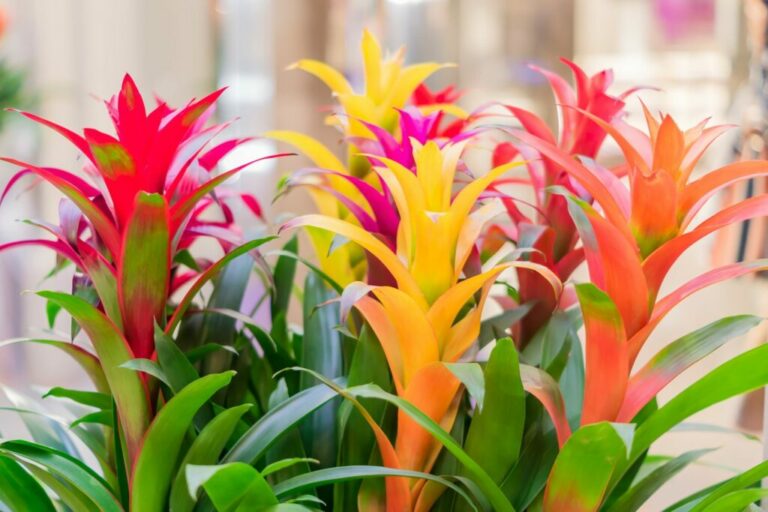Bromeliads (Bromeliaceae genera) are a diverse group of plants that are known for their unique rosette-shaped foliage and striking flowers. They are native to tropical regions and have adapted to various growing conditions, making them a popular choice for indoor and outdoor gardening. They are relatively easy to care for, requiring bright, filtered light and moderate to high humidity. They are also tolerant of dry conditions, making them a great choice for those in arid regions.
Most popular Bromeliad varieties:
- Earth Star
- Urn Plant
- Flaming Sword
- Scarlet Star
- Blushing Bromeliad
Care
Even though Bromeliads are not particularly hard to care for, to get them to bloom, particular growing conditions are necessary and these conditions differ between species. Temperature, humidity, day length, water, and feeding all influence the plant’s blooming cycle. Indoors, bromeliads are typically planted in a mixture of soil and sand and can be watered by either dampening the soil or filling the central depression of the plant. Here are some specific tips for you to care for your Bromeliads:
- Soil: Indoor bromeliads do very well in potting soil that drains well but holds moisture. A combination of two-thirds peat-based soil and one-third sand, as well as orchid mix, charcoal, and soilless potting mix, can be used.
- Water: Even though Bromeliads can tolerate drought, they prefer moist soil (not waterlogged). It is usually not necessary to keep the central cup filled with water. They require sparse watering through the soil weekly during the growing season, reducing it during the winter rest period.
- Temperature: Bromeliads grow naturally in tropical, humid, and shady forest floors, so it’s important to recreate those conditions. They can tolerate temperature changes, but they need protection from cold and prefer temperatures between 60 and 85 degrees Fahrenheit.
- Light: Bromeliads have different light requirements depending on their genus, but most prefer bright indirect light. Varieties with soft, flexible leaves do well in lower light levels, while those with stiff, hard leaves need bright indirect light and can tolerate full tropical sun.
Give it a read

Propagation
Bromeliads can be propagated through offsets, which are produced by mature plants. They are often grown for their showy bracts that can last for several months. To separate the pup from the mother plant, use your hands or a cutting tool to make a clean cut as low as possible. Even without roots, bromeliads can survive and obtain water and nutrients from the central cups, but it’s best to get as much plant material as possible to help the young plant establish itself.
Common Pests
Pruning
When it comes to bromeliad plants, pruning is generally not a major concern. Feel free to remove any dead or dying leaves whenever necessary.
Once the flower spike withers away, it’s advisable to trim it off. However, make sure to keep the main plant alive for as long as possible to allow ample time for “pups” (new offshoots) to grow.
When the main plant eventually declines, you can prune it out while leaving the pups to continue thriving in the pot. Alternatively, you have the option to separate the pups from the deceased mother plant and pot them individually.
Frequently Asked Questions
Well, they look beautiful and do not require much care, thus it is safe to say that Bromeliads are good indoor plants for anyone.
Do bromeliads only flower once?
There are some exceptions, but bromeliads usually flower once in their lifespan. After that, they only produce offsets that can be used for propagating new bromeliads.
What month do bromeliads flower?
Bromeliads usually flower between April and October (warmer months), but only about 2-3 years after being separated from their parent plants. Also, they only bloom once in their lifespan.
Do bromeliads like sun or shade?
Most Bromeliads like indirect, bright sunlight or partial shade.
How often to water a bromeliad plant?
You should water your bromeliad plant once every week in warmer months, and only once every 2-3 weeks in the colder months.

